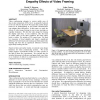Free Online Productivity Tools
i2Speak
i2Symbol
i2OCR
iTex2Img
iWeb2Print
iWeb2Shot
i2Type
iPdf2Split
iPdf2Merge
i2Bopomofo
i2Arabic
i2Style
i2Image
i2PDF
iLatex2Rtf
Sci2ools
CHI
2009
ACM
2009
ACM
More than face-to-face: empathy effects of video framing
Video conferencing attempts to convey subtle cues of face-to-face interaction (F2F), but it is generally believed to be less effective than F2F. We argue that careful design based on an understanding of non-verbal communication can mitigate these differences. In this paper, we study the effects of video image framing in one-on-one meetings on empathy formation. We alter the video image by framing the display such that, in one condition, only the head is visible while, in the other condition, the entire upper body is visible. We include a F2F control case. We used two measures of dyad empathy and found a significant difference between head-only framing and both upper-body framing and F2F, but no significant difference between upper-body framing and F2F. Based on these and earlier results, we present some design heuristics for video conferencing systems. We revisit earlier negative experimental results on video systems in the light of these new experiments. We conclude that for systems ...
CHI 2009 | F2F Control Case | Human Computer Interaction | Video Conferencing Attempts | Video Conferencing Systems |
Related Content
| Added | 24 Nov 2009 |
| Updated | 24 Nov 2009 |
| Type | Conference |
| Year | 2009 |
| Where | CHI |
| Authors | David T. Nguyen, John F. Canny |
Comments (0)

